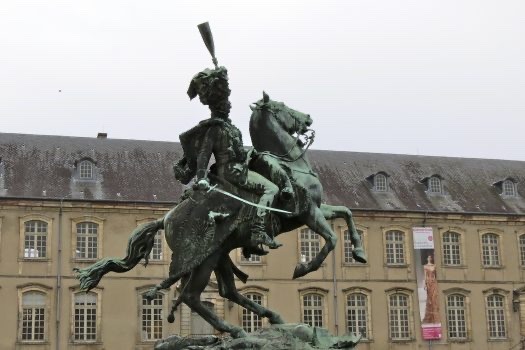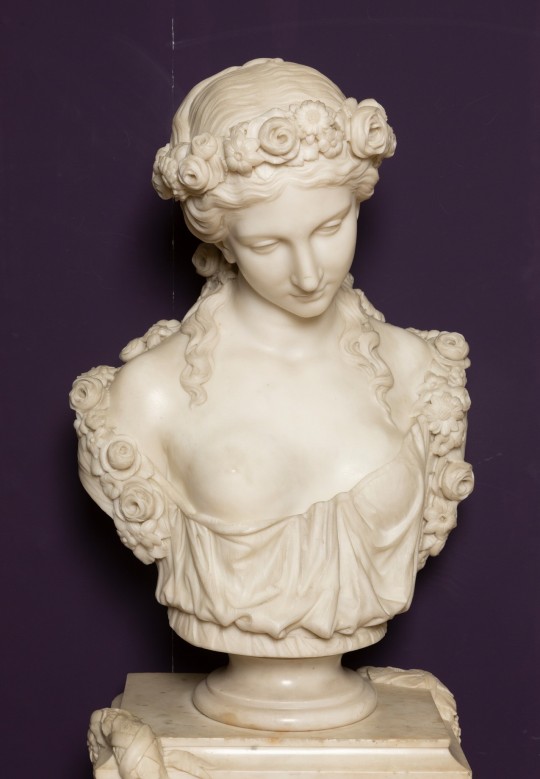#Henri Joseph Charles Cordier
Text


Bronze statue of Antoine Charles Louis de Lasalle, cavalry general during the Napoleonic Wars.
Lunéville, France (Lorraine region)
Artist: Henri Joseph Charles Cordier
96 notes
·
View notes
Text






Douai (Nord), le Musée de la Chartreuse. Une visite pour la Nuit des Musées. Ici, on est dans la chapelle.
Charles-Henri-Joseph Cordier : "La Nymphe des Eaux"
Théophile Bra : "Aristodème au tombeau de sa fille"
Eugène-Ernest Chrétien : "Le Printemps"
Patricia Zurini : "Ceci n'était pas mon temps…"
les 2 dernières : le choeur des mineurs polonais
#douai#chartreuse#musée de la chartreuse#statue#charles-henri-joseph cordier#cordier#nymphe#théophile bra#bra#aristodème#eugène-ernest chrétien#printemps#patricia zurini#zurini#art contemporain#choeur#mineurs#pologne
8 notes
·
View notes
Text

Vénus Africaine
Sculpture by Charles-Henri-Joseph Cordier
bronze, rich dark-brown, silvered and gilt patina, ca. 1855-1900
#Charles-Henri-Joseph Cordier#art#artist#sculptor#sculpture#Vénus Africaine#bronze rich dark-brown silvered and gilt patina#ca. 1855-1900#Sculpture by Charles-Henri-Joseph Cordier
69 notes
·
View notes
Text






Various pieces by French sculptor Charles-Henri-Joseph Cordier
"Woman from the French Colonies", 1861. Originally titled La Capresse des Colonies (The Goat Tender from the Colonies)
"Jewish Woman of Algiers", 1862.
"Bust after Seïd Enkess", 1848. The sitter is Seïd Enkess, a formerly enslaved Sudanese man from Darfur. Titled as Nègre de Timbouctou (Negro from Timbuktu).
"Bust of a Woman", 1851. Debuted under the title Négresse des colonies (Negress of the Colonies)
While women of colour, fashioned in white marble or coloured materials, were unusual subjects in nineteenth-century sculpture, there are significant examples of works representing them as erotically charged and bound slaves, sexualised Venuses, or a hybrid of both. These reveal conflicting attitudes towards race, sexuality, slavery and abolition. White male sculptors such as John Bell and Charles Cordier intended to bring the pathos of the institution of slavery to public attention, yet they nonetheless traded on the allure of illicit sexuality born of that same system. Many works in this gallery evoke both vixen and victim.
32 notes
·
View notes
Text

Charles-Henri-Joseph Cordier, Man from Sudan in Algerian Dress, c. 1850-1857, Silvered bronze, Algerian jasper, porphyry, 8/20/24 #artsmia
0 notes
Text

African Venus
Charles-Henri-Joseph Cordier (French, 1827-1905) (Artist)
1852
bronze and gold
(18th and 19th Centuries )
0 notes
Text
Charles Cordier was zich bewust van de alomvattende schoonheid
Charles Henri Joseph Cordier (1827-1905) was een Franse beeldhouwer van etnografische onderwerpen.
Cordier werd geboren in Kamerijk. In 1847 bepaalde een ontmoeting met Seïd Enkess, een voormalige zwarte slaafgemaakte die model was geworden, het verloop van zijn carrière. Zijn eerste succes was een buste in gips van een Soedanese man: Saïd Abdullah van de Mayac, Koninkrijk van Darfur (Soedan).…

View On WordPress
#1848#19-de eeuws#afschaffing slavernij#beeldhouwer#etnografisch#eurocentrisch#Europese types#Frans#model#overal schoonheid#Parijse Salon#Saïd Abdullah#Seïd Enkess#slaafgemaakt
0 notes
Photo

The Goat Tender of the Colonies
-Charles-Henri-Joseph Cordier. 1861
1 note
·
View note
Photo

Bust of a Nymph by Charles-Henri-Joseph Cordier (1860)
#charles-henri-joseph cordier#art#sculpture#statue#fine art#19th century#19th century art#academism#academicism#academic art#french art#french artist#mythology#roman mythology#dryad#forest nymph#bust#charles cordier#marble sculpture#classic art
2K notes
·
View notes
Photo

Charles Cordier (1827-1905)
“Negre du Sudan” (1856-1857)
Bronze and onyx with a porphyry pedestal
Located in the Musée d'Orsay, Paris, France
This was one of Cordier’s first polychrome works; the face is made of bronze and the mantle and turban of onyx marble from Algeria. Onyx marble characteristically ranges in colour from red to white, with stripes running through the blocks of stone, Cordier used these features to render the colorful effect of patterned fabric. The metal surface of the sculpture was initially silvered, then oxidised, which blackened it. Such use of color was a novelty at the time when people were accustomed to seeing white marble or bronze sculptures.
Nothing is known of the model who posed for Cordier except that he played the tam-tam in the festivities of Alger’s Muslim community before Ramadan. In an admiring, respectful manner, Cordier managed to render his natural nobility, which prompted comparisons with Roman emperors.
#sculptures#art#artwork#portrait sculpture#male bust#charles henri joseph cordier#bronze statue#onyx#porphy#stone#rock#musée d'orsay#musee#museum#art gallery#portrait of a man#history#african#sudanese#handsome#clothes#clothing#turban#aesthetic#aesthetics#beautiful#1856#1857#1850s#mid 1800s
545 notes
·
View notes
Photo

The Jewish Woman of Algiers
Sculpture by Charles Henri Joseph Cordier
Algerian onyx-marble, bronze, gilt bronze, enamel, and amethyst eyes
1862
#Charles Henri Joseph Cordier#art#artist#sculptor#Charles Cordier#Sculpture by Charles Henri Joseph Cordier#beautiful#The Jewish Woman of Algiers#Algerian onyx-marble bronze gilt bronze enamel and amethyst eyes#sculpture#1862
16 notes
·
View notes
Text

“Bust of a Woman” by Charles-Henri-Joseph Cordier, which came to be identified only as “African Venus.”
Credit...Clark Hodgin
https://en.wikipedia.org/wiki/Charles_Cordier
17 notes
·
View notes
Photo

Bust of Said Abdullah of the Darfour People, Charles Henri Joseph Cordier, 1848, Art Institute of Chicago: European Painting and Sculpture
Ada Turnbull Hertle Endowment
Size: H. 82.5 cm (32 1/2 in.) (with socle) H. 71.3 cm (28 1/8 in.) (without socle)
Medium: Bronze
https://www.artic.edu/artworks/18751/
81 notes
·
View notes
Text






1 - “La Capresse des Colonies”, Charles Henri Joseph Cordier
3 - Angela Davis
4 - @deadpoet02
6 - James Kakgone
2K notes
·
View notes
Photo











Charles Henri Joseph Cordier (French, 1827-1905) - African Woman - bronze - 1851
Pietro Calvi (Italian, 1833-1884) - Aida - marble and bronze with gilding
Constantin Brâncuși (Romanian, 1876-1957) - Sleeping Muse - bronze - 1910
Francisco dos Santos (Portuguese, 1878-1930) - Invocação (Invocation) - marble - 1916
Henryk Kuna (Polish, 1879-1945) - Głowa świętej (Holy head, two views) - bronze - 1926
Pedro de Torre-Isunza (Spanish, 1892-1982) - bronze
Arturo Dazzi (Italian, 1881-1966) - Serafina - marble - 1920
Augusta Savage (American,1892-1962) - Gwendolyn Knight - bronze - 1934-35
Bruno Walpoth (Italian, b.1959) - Lontane speranze - nut wood, paint - 2015
Damien Hirst (British, b.1965) - Aspect of Katie Ishtar ¥o-landi - from Treasures from the Wreck of the Unbelievable - partially gilt bronze - 2016-2017
Christian Zucconi (Italian, b.1978) - Testa (Head) - Persian travertine - 2017
#art by others#other's artwork#sculpture#female head#woman's head#stone#bronze#marble#travertine#wood#gilding#Christian Zucconi#Damien Hirst#Bruno Walpoth#Augusta Savage#Arturo Dazzi#Pedro de Torre-Isunza#Henryk Kuna#Francisco dos Santos#Constantin Brâncuși#Pietro Calvi#Charles Henri Joseph Cordier
369 notes
·
View notes
